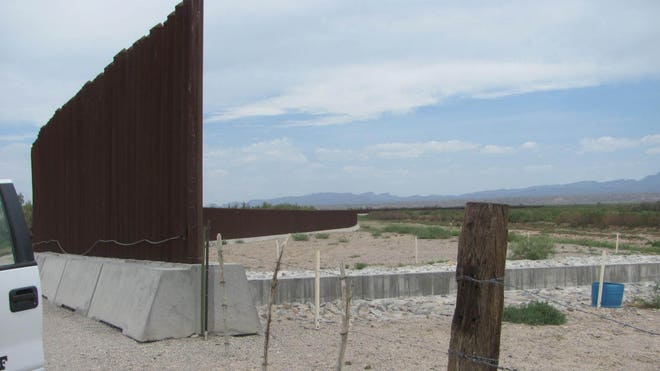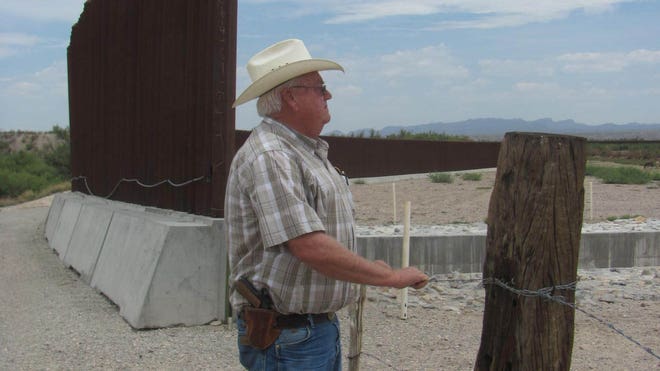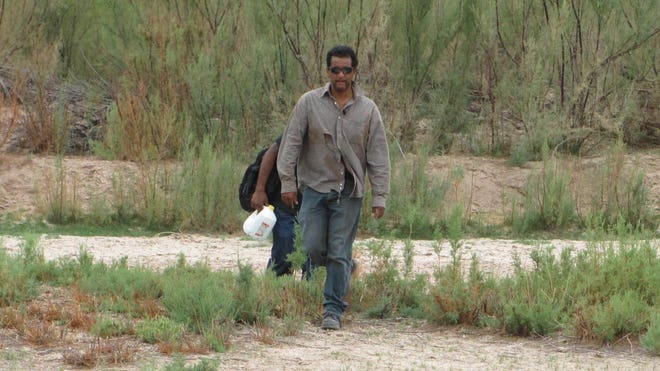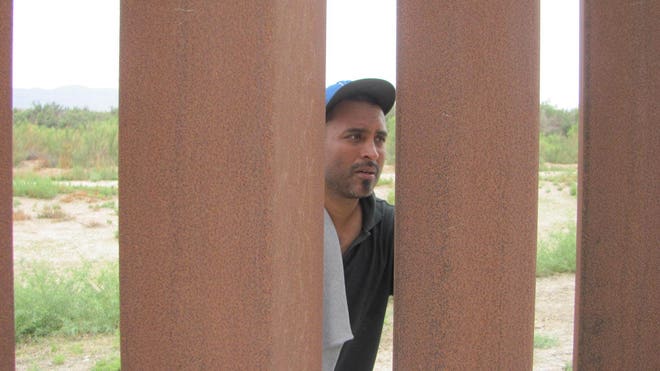Fort Hancock, Texas: Where a fence and hope for illegals endsBy Joseph J. KolbPublished July 01, 2013FoxNews.com
 In Fort Hancock, Texas, the U.S. border fence ends abruptly. (Photos by Joseph Kolb)
In Fort Hancock, Texas, the U.S. border fence ends abruptly. (Photos by Joseph Kolb) Hudspeth County Sheriff Deputy Johnny Schuller stands next to a source of frustration for residents in the area where the border security fence comes to a dead end in the middle of the desert leaving four strands of barbed wire to separate the U.S. from Mexico.
Hudspeth County Sheriff Deputy Johnny Schuller stands next to a source of frustration for residents in the area where the border security fence comes to a dead end in the middle of the desert leaving four strands of barbed wire to separate the U.S. from Mexico. Two migrants from Durango state, were the subjects of a search and rescue mission after the smuggler who was supposed to guide them into the U.S. became lost and left the two on their own in triple-digit temperatures.
Two migrants from Durango state, were the subjects of a search and rescue mission after the smuggler who was supposed to guide them into the U.S. became lost and left the two on their own in triple-digit temperatures. Hungry and dehydrated, David Garcia, 25, Durango state, Mexico, snug into the U.S. by walking around the end of the 18 feet high fence in Fort Hancock, Texas, early Thursday morning.
Hungry and dehydrated, David Garcia, 25, Durango state, Mexico, snug into the U.S. by walking around the end of the 18 feet high fence in Fort Hancock, Texas, early Thursday morning.
Next Slide Previous Slide The knock on Lupe Dempsey’s door Friday at the Horse Shoe D ranch, less than a half mile from the Mexican border, hardly surprised the retired Immigration and Customs Enforcement agent.
On her doorstep was a 25-year-old man named Juan who, thirsty and disoriented, told how he’d become lost after illegally crossing the border and had wandered the desert in 110-degree heat. His story was not unique to Dempsey and others in this west Texas town, where the 18-foot-high U.S. border fence ends abruptly, giving way to a few strands of barbed wire.
Residents say Mexicans wander along the southern side of the border fence for days, searching for the terminus, where – if they make it – crossing is easy. Juan told Dempsey he was from Zacatecas state in central Mexico. He said he had been with three other men, including a 20-year-old rookie coyote – slang for the guides who migrants into the U.S.
Juan paid the young coyote’s managers $3,000, but the group got lost in the scorching desert and split up. And as Juan learned, just getting across the border doesn't guarantee illegal immigrants anything – they’re still in parched land that ranges from desert to barren scrubland.
“While it may keep people out in those areas of the fence, it pushes the migrants into more remote areas where it is easy to get lost, it is very dangerous."
- Lupe Dempsey, Texas rancher
“I know what he’s going through so I fed him and gave him water,” Dempsey said. “He was very grateful and told me he wanted to go home.”
Crossing into a city, such as El Paso, puts the immigrants in position to get help, if not food and a job. But following the segmented border fence 50 miles south east to Fort Hancock, population 1,750, puts them smack in the middle of nowhere.
“While it may keep people out in those areas of the fence, it pushes the migrants into more remote areas where it is easy to get lost, it is very dangerous,” Dempsey said.
Dempsey called Hudspeth County Sheriff's Deputy Johnny Schuller, who later turned Juan over to the U.S. Border Patrol. There is nothing for men like Juan in Fort Hancock, where extreme drought has turned once fertile fields of green cotton into dust. Dozens of businesses and ranch homes have been abandoned, many with skeletal roof beams exposed to the blistering sun.
Those who have remained are disdainful of lawmakers who think they have a solution to border security and never ask the locals what is needed.
The sentiment here about the Senate-approved Hoeven-Coker Amendment, which calls for an additional 700 miles of fencing and 20,000 Border Patrol agents, is that it is another example of a disconnection from reality in Washington.
Surges in border security has had deadly results. A"funneling effect", where migrants move away from fenced areas, has resulted in Texas overtaking Arizona with the most migrant deaths. In 2012 the Texas Civil Rights Project reported 271 border deaths in 2012. Brooks County, 70 miles from the border, accounted for the highest number with 129.
Ruben Garcia, executive director at Annunciation House, a nonprofit immigrant shelter in El Paso, Texas, said he has seen the effects of "funneling" first hand.
"If we haven't learned anything, when we do these operations it forces desperate people to take more desperate risks," Garcia said.
Since retiring from ICE, Dempsey has been working as an interpreter in an immigration court and has seen the issue evolve over her career firsthand and says the system is working.
“We already have very strict immigration laws government never provided the funding for,” Dempsey said. “We don’t need more laws, we just need to enforce what’s on the books.”
Schuller said when he was patrolling the border during the early days of his career there was great synergy between local law enforcement and the Border Patrol. But since the establishment of the Department of Homeland Security in 2003, Schuller, said that cooperation has waned.
“It’s almost an us-and-them mentality, they rarely ask for our advice and cooperation and we are from here and know what goes on better than they do,” said a frustrated Schuller.
As he spoke, two of the missing migrants who had come over with Juan emerged from the shrubs and trees that line the Rio Grande River bed and wandered to the tall rusted metal poles that make up the fence.
Dirty and struggling to walk, the men identified themselves as Enrique Jose, 40, and David Garcia, 35, both of Durango state. They said they had been wandering among the mesquite, greasewood, yucca, and cactus for three days without food and only a small amount of water.
“We want to go back to Juarez,” Jose said. “My feet hurt so bad.”
The men said they crossed the border in the nearby gap in the metal fence which is protected only by four strands of barbed wire on weather beaten posts just barely able to hold the fence vertical. There ultimate goal being to find employment in the U.S.
“After we got lost, we decided we wanted to go home, so we climbed the fence back into Mexico,” Jose said.
For West Texans like Dempsey and Schuller, their compassion for migrants runs as deep as their frustration with the federal government when it comes to border policy.
“It’s a sad story, God bless them,” Schuller said as Garcia and Jose shuffled back to the river with less than a half bottle of water each.
Read more:
http://www.foxnews.com/us/2013/07/01/fort-hancock-texas-where-fence-and-hope-for-illegals-ends/#ixzz2XqrEirQF